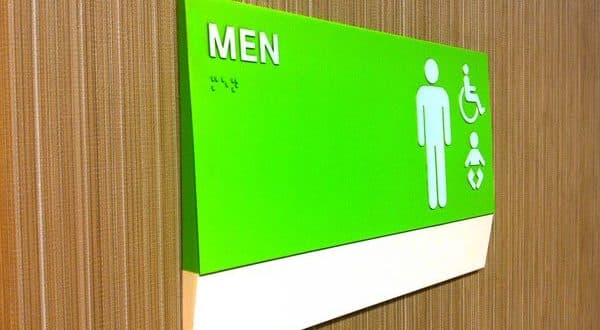Update: Canadian Accessibility For Signage
Canadian ADA Update
A person taking a big picture snapshot of Disability Codes in Canada in the last three years since we wrote the Canadian Accessibility White Paper may come away disappointed. There has been very little action taken at either the federal of provincial level. Look a little more closely though and a fascinating picture emerges. An industry has emerged of disability sign specialists and fabricators that have developed best practices based on the Americans with Disabilities Act (ADA) and existing Canadian guidelines and standards.
The Ontarians With Disability Act. The 1000 Pound Bear in the Room.
The Ontarians with Disabilities Act (AODA), which passed in 2005, addressed the need to remove barriers for the disabled in the environment, and a formal standard was proposed in 2010 and adopted in June 2011 (Profiled in the Canadian White Paper). This sign standard is a simplified version in the International Building Codes and many sign companies have used the rest of the International Building Code and the ADA to address other areas including sign contrast and tactile letter standards.
Obviously the AODA , as a code that serves over 1/3 the population of the country, has an enormous influence, but it also effect the provinces that do not have specific codes. Canadian companies have grown to meet Ontario’s demands (some like KING Architectural were leaders well before the AODA) and have pushed these code practices as best practices for the other provinces along with the ADA. This is very similar to what happened when newer guidelines were passed in some states after the ADA was first adopted based on more advanced work by the International Code Committee. Other states gravitated to the high guideline standards and they were common industry practice even before the ADA was adopted at the federal level.
The Treasury Board and the Federal Identity Program
While direct codes have not made a big impact in Canada, other guidelines have had an enormous influence. The Treasury board, which is responsible for regulations concerning all other government agencies, said that tactile signs be required in all government buildings either owned or leased. Tactile signage must be used for “washrooms, emergency egress, elevators, stairwells and doors off main corridors”(from the Treasury Board Manual). This was closely adopted by the Federal Identity Program in 1997 which worked closely with a number of associations and disability experts to adopt specific guidelines for signs, much of which is based on Canadian Standard Association Guidelines (CAN/CSA B-651 95 Barrier-Free Design).
Over the last 15 years these guidelines have had an enormous impact, not just on government buildings, but also providing a standard for all building. Elements like multi-lingual design, use of Helvetica as a standard font, and standard symbols have worked their way into best practices well beyond government signs to the point of becoming a “Canadian brand”.
Influence of the ADA and IBC
The Americans with Disability and International Building Code has also had an enormous impact on Canadian accessible signage. Canada is both a leading home and outpost for multi-national corporations who are striving to develop consistent sign standards for their organizations. The new ADA is often seen as the is the most common for sign guidelines in Canada, because of the close relationship with American companies.
Leadership of Sign Fabricators
Sign fabricators and designers have played a leading role of ensuring that new buildings adopt sign standards. This leadership includes marketing ADA and OADA solutions as part of wayfinding solutions, particularly for hospitals and university campuses. The other is the selling of accessibility products including standard symbols signs for Restrooms and Exits. This industry growth couples with more expansive education campaigns have made accessible signs a priority on any new project.
Download our Canadian Accessibility White Paper
View Canadian Accessibility Codes



